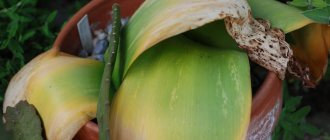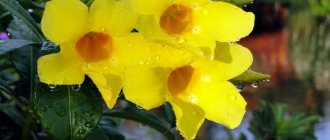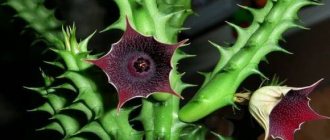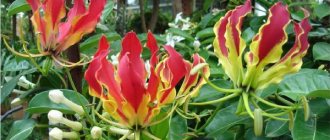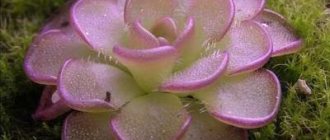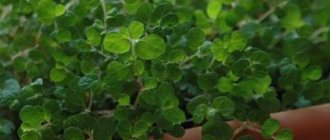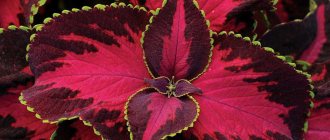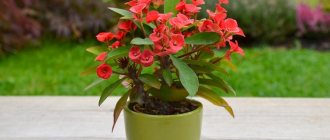What does Hymenocallis look like and where does it come from?
Hymenocallis, a plant with fancy snow-white flowers reminiscent of lilies with very thin petals, belongs to the Amaryllis family. The genus includes more than 60 species of herbaceous bulbous perennials, native to the southeastern United States, Mexico, the Caribbean islands, and northern South America. Some species live in humid areas, preferring swamps and coastlines. Others, on the contrary, grow on grassy slopes of hills and mountains.
Peduncles grow from rosettes formed by long, strap-like leaves with a pointed tip. Their surface is glossy, painted in a bright green tone.
The genus name Hymenocallis comes from the Greek words ὑμήν, meaning “membrane,” and καλός, meaning “beautiful.”
The flowers have a very unusual shape. They consist of six narrow, strongly curved petals attached to a shallow “bowl”. The stamens are very large, the anthers are saffron or bright orange. It has a pronounced pleasant aroma, which many associate with vanilla.
Because of its thin petals, the shape of which resembles spider legs, Hymenocallis is called the “spider lily.”
Due to its structure, the flower resembles a large insect. Because of this, people called it the “spider lily.” Hymenocallis is also known under other memorable poetic names - “bride's basket”, “angel trumpets”, “Peruvian narcissus”.
Like all Amaryllis, Hymenocallis has a bulb. It is quite large (in a mature plant it reaches 10 cm in diameter), has a pear shape and is covered with dry scales.
Video: Hymenocallis blooming
Hymenocallis. Botanical description
The plant is a representative of the genus Hymenocallis of the Amaryllis family. Native to Latin America and the Caribbean. In some sources the flower is called Hymenocallis festalis, but this is not true. Hymenocallis festalis is a flower of the genus Ismene, family Amaryllis.
Hymenocallis in its bloom looks like a white spider
The hymenocallis flower has a pear-shaped bulb with bright dry scales. As the bulb matures, it can reach a diameter of 12 cm. The pointed, sword-shaped leaves up to 1 m long are bright green in color.
The flowers of the culture look like a lily or a star, and for some they resemble a spider. The buds are located on a long hollow tube and bloom into narrow sepals. The flower is white with a green base, 12-17 cm in diameter. 6-8 flowers with a pleasant aroma are formed in umbrella inflorescences.
The flowers of the culture remind someone of a lily or a star
Interesting! Hymenocallis has beneficial medicinal properties. In medicine, preparations based on the plant are used in the treatment of pulmonary and kidney diseases, and eliminate edema.
Hymenocallis and ismene: how to distinguish?
Ismene and Hymenocallis are two plants belonging to the same Amaryllis family. Until recently, it was believed that these were the names of the same flower. However, botanists have proven that they belong to different genera. Nevertheless, the vast majority of hymenocallis bulbs supplied to Russia from the Netherlands are still listed under the name “ismene”.
Not only a professional botanist, but also an amateur gardener can distinguish ismene (pictured on the left) from hymenocallis (pictured on the right)
Table: how to distinguish hymenocallis from ismene
| Criteria | Hymenocallis | Ismene |
| Flower | Snow-white flower. The buds are directed upwards. | The bases of the stamens inside the calyx are always colored greenish. The flowers “look” down or to the sides. |
| Leaves | The leaves form a rosette close to the soil. | The flowers bloom on a pseudostem. |
| Winter holidays | Some species (for example, Hymenocallis Caribbean) are evergreen and do not have a dormant period; flowering occurs in winter. Others shed their leaves in the fall. | There is a pronounced dormant period; the bulbs are stored at a temperature of 12–14°C. |
How a plant reacts to the grower’s mistakes: why it doesn’t bloom and more - table
An unambiguous signal indicating incorrect actions when growing hymenocallis is the lack of flowering. Also, errors in care affect the condition of the leaves.
| Problem | Most likely causes |
| Lack of flowering. | The plant does not have enough light, nutrition, or is not watered correctly. Another possible reason is not provided or a very short period of rest. |
| Falling buds that have not had time to bloom. | During the active growing season, the flower is watered irregularly. |
| Darkened or blackened flowers. | The room is too cold and/or damp. |
| Light spots of irregular shape on the leaves. | Hymenocallis got burned after standing in direct sunlight for too long. |
| Drooping, gradually discolored leaves until translucent. | The soil in the pot often dries out. |
| Yellowness spreading across the leaf from bottom to top. | The plant is watered too often and/or too much. If watering is not adjusted, rot will likely develop. |
Popular species in indoor floriculture
All types of hymenocallis grown at home (there are relatively few of them) have snow-white flowers. Despite such monotony, any of them looks very elegant, decorative and elegant. The best ways to adapt to the microclimate of modern apartments are:
- Hymenocallis is pleasant (early). The belt-shaped leaf blades are painted in an emerald hue. They reach 40 cm in length and about 7 cm in width. Flowering begins in July and may repeat in September. In winter, Hymenocallis has a pleasant period of “sleep”. After flowering ends, the leaves die off, and the bulb rests, gaining strength before the new season of active growth.
- Hymenocallis Caribbean. The snow-white flowers and bright green leaf blades are very similar in appearance to Hymenocallis pleasant. The only difference is that the buds are collected in 6-12 pieces in inflorescences in the form of an umbrella or shield. They bloom in winter. The plant is evergreen and does not require a pronounced dormant period.
- Hymenocallis latifolia. It reaches a height of 80–90 cm. The leaf blades have a linear shape. The flowers are tubular, the petals are colored greenish, and bend back like sepals.
- Coastal Hymenocallis. The flowers are very reminiscent of daffodils. Petals are pastel yellow. A distinctive feature of this species is the color of the leaves. Their bright green background contains longitudinal grayish stripes.
Photo gallery: Hymenocallis Caribbean, pleasant and other species grown at home
Hymenocallis pleasant needs a period of rest. The difference between Hymenocallis Caribbean and other species is that the buds are collected in 6-12 pieces in inflorescences in the form of an umbrella. The flowers of Hymenocallis coastal have a tubular shape, the petals, painted in a greenish tint, bend back like sepals. A distinctive feature of Hymenocallis latifolia - the presence of grayish stripes on the leaves
Types of indoor hymenocallis with photos and names
The genus Hymenocallis has more than 50 representatives, describing all of them will take a lot of time, so we will focus on the most common ones.
Hymenocallis speciosa
An evergreen representative from the Antilles. Among other things, it differs from its relatives in a peduncle with an umbrella of flowers, each of which reaches a diameter of up to 15 cm, and the sepals curved into an arc often reach 7 cm.
Hymenocallis caribaea
An evergreen trunk with a flowering period of 4 months arrived to us from the Antilles. It is he who is most popular among flower growers. It is distinguished by its dark green leaves and an umbrella of large flowers with long sepals.
Hymenocallis narcissiflora
This species is native to Peru and is distinguished by the yellow color of its petals and the placement of its stamens, which are entirely contained within a crown of fused petals. There are varieties with purple and white flowers; the flowering period is long, starting in mid-summer and lasting until mid-autumn.
Festive Hymenocallis, pleasant Hymenocallis x festalis
This representative of Amaryllidaceae is a hybrid of Basketball and Elisen Hymenocallis. It is distinguished by pink fragrant flowers on a tall peduncle; Peru is considered its homeland. It blooms with large flowers for 2-3 months.
How to create an optimal microclimate for a plant?
Hymenocallis is native to tropical rainforests. The microclimate there is radically different from the conditions in modern apartments. Therefore, before purchasing a plant, you should familiarize yourself with its “wishes” and take them into account, ensuring, if possible, optimal lighting, temperature and humidity.
Table: what conditions are required for hymenocallis depending on the season
| Season | Lighting | Humidity | Temperature |
| Spring Summer | Hymenocallis is one of the most light-loving plants among the Amaryllis. The flower tolerates direct sunlight well. Place it on windows facing south, southeast or southwest. In summer you can take it out onto the balcony or plant it in the garden. | Humidity is not important for hymenocallis. In extreme heat, spraying with water at room temperature once every 2-3 days is useful, if the drops do not fall on the flowers and buds. | 23–25ºС. After the plant has flowered, it is lowered to 16–18ºС. |
| Autumn winter | For winter-flowering plants in most of Russia, additional illumination with fluorescent or special phytolamps is necessary (minimum daylight hours - 10 hours). For species that have a pronounced dormant period, light is not required in winter; store the bulbs in a dark place. | Hymenocallis does not need to be sprayed or given a shower. The flower tolerates dry air in the apartment very well. | 10–12ºС. |
Reproduction of Hymenocallis
Hymenocallis propagation occurs in three ways:
- Seeds. The method is labor-intensive and unjustified. Seeds are sown in moist sandy-peaty soil. The first sprouts hatch by the end of the third week, and can sit in the ground for up to three months. Further care of the seedlings consists of proper regular watering and protection from direct sunlight.
- Daughter bulbs. During transplantation, the baby bulbs are separated from the mother plant and planted in a separate container with sand and peat. Place in a shaded place until germination. Next, using the transshipment method, they are transplanted into the prepared soil mixture and cared for as an adult plant.
- By dividing the bulb. Sometimes it happens that the culture does not grow daughter bulbs or is old. Then the method of dividing the bulb is suitable for propagation. To do this, it is cut into 2 or 4 parts with a sharp sterile knife. On each part there should be a piece of the bottom and neck. The sections are sprinkled with ash, cinnamon or crushed coal and left to dry for 3 hours. Then they are germinated in wet sand or sawdust for about two weeks until roots form. Then comes the transplant and standard care.
Propagation of hymenocallis by daughter bulbs is the easiest way
Planting and transplanting procedure
Hymenocallis does not need annual transplantation. The bulbs increase in size quite slowly. Therefore, for young plants, one procedure once every 2-3 years is enough, for adults - every 4-5 years. The best time for it is the end of winter or the very beginning of spring.
Making up the substrate
To grow spider lilies, loose and nutritious soil with a slightly acidic reaction (pH 5.0–6.0) is required. You can make a mixture yourself from turf soil, leaf humus, peat and coarse river sand (2:2:2:1). Purchased soil for Amaryllis or bulbous plants is also suitable if you add small pieces of charcoal or red brick crumbs to it (about 1/5 of the total volume of the finished mixture).
Choosing a flower pot
Hymenocallis has a fairly powerful root system, so you should choose a spacious pot for planting. The correct container is 7–10 cm in diameter larger than the onion. There must be drainage holes in the bottom of the container to drain excess moisture . For each subsequent transplant, you should select a container 2 cm larger in diameter than the previous one. A pot that is too large is also undesirable; the growth and development of hymenocallis is greatly inhibited while the roots develop new space.
Step-by-step instructions for transplantation
- Place drainage at the bottom of the container: gravel, expanded clay or pebbles.
When transplanting hymenocallis, it is necessary to create a drainage layer at least 3–4 cm thick at the bottom of the pot.
- Pour the substrate on top, taking up about half the volume of the pot. Next is a thin (several millimeters) layer of fine sand. This will prevent the bulb from rotting.
- Moisten the soil and place the bulb in the center of the container. Fill it in so that half of it rises above the soil surface.
Half of the hymenocallis bulb should protrude above the surface of the substrate
- Water the soil again so that the drops do not fall on the bulb, and place the pot in partial shade. When new leaves begin to appear, return the container to its “permanent place of residence.”
Features of planting in open ground
Before planting the hymenocallis bulb in open ground, it must be allowed to germinate. To do this, a month before the planned procedure (approximately mid-April), place it in a bowl with peat chips mixed with small wood shavings (1:1). Moisten the substrate periodically without letting it dry out.
Hymenocallis is not only a potted plant; in areas with warm climates it can also be grown in a flower bed
In mid-May, plant the hymenocallis in the flowerbed, after thoroughly digging the soil. The bulb should rise about a third above the ground surface. To prevent rotting, a handful of sand should be poured into the bottom of the hole.
What are the problems when growing Hymenocallis?
Growing hymenocallis is not a simple process; it can be difficult for a novice gardener to meet all the conditions for growing a plant, so we have prepared a list of symptoms or incorrect actions to answer the most frequently asked questions:
Plant/Bulb disappears
- Excessive, irregular watering. As a result, the plant rots and disappears. The first sign is yellowing of the leaves.
- Watering according to the recommendations, but carried out directly on the bulb. The neck of the plant is wet all the time, it gets wet and disappears.
- Inattention of the owner, neglect of diseases.
- Wrong landing site.
Why doesn't Hymenocallis bloom?
- With flowering, the opposite is true; if the plant does not have enough moisture, it does not bloom.
- If you choose a non-sunny location.
- There was no rest period at home.
- Failure to comply with temperature conditions.
The hymenocallis plant is quite capricious when growing, but if you achieve stable growth and abundant flowering, then the delicate smell of this daylily will be remembered forever.
How to care for the “spider lily”?
Hymenocallis is by no means as capricious and demanding as it might seem at first glance at tropical exotica. But this does not mean that it will feel comfortable and bloom regularly in the complete absence of care on the part of the grower.
Choosing a place for the plant
Hymenocallis loves bright, intense light and thrives in direct sunlight. Indoors, it is recommended to place it on the windowsills of windows facing south. In summer, it is advisable to place the plant on the balcony, as well as take it out or plant it in the garden.
Watering the flower correctly
Hymenocallis requires abundant watering; the plant does not tolerate dry soil very well. But excess moisture is also dangerous - rot develops quickly.
During active growth, water the flower with soft, settled water, heated to a temperature slightly above room temperature, as soon as the top layer of soil dries. Usually one procedure every 2-3 days is enough; in extreme heat it is carried out daily. In August and before the start of flowering, watering volumes should be slightly reduced, but the soil should not be allowed to dry out.
Feeding the plant
Hymenocallis needs feeding only in the first half of summer. At this time, it can be watered once a week with a solution of complex mineral fertilizer for flowering indoor plants or a special product for bulbous plants, prepared strictly according to the instructions. It is strongly not recommended to use organic fertilizers, as this does not promote flowering.
How to make it bloom?
The flowering period of Hymenocallis depends on its type. For example, Caribbean usually blooms in winter, pleasant - in early summer. If your “spider lily” does not want to produce buds, then perhaps the right time has not yet come. In order not to wait in vain, when purchasing, be sure to specify which variety you are purchasing.
To stimulate flowering, a slightly lower temperature than usual (16–18ºС) is required. With the onset of autumn, Hymenocallis Caribbean should be placed in a bright place and watering should be reduced. With this maintenance, the plant will produce a peduncle at the beginning of winter.
The flowering time of Hymenocallis depends on its type
In order for the pleasant hymenocallis to bloom, it is necessary to sharply limit watering in the fall, and when the leaves dry, cut them off as close to the soil surface as possible and move the container with the bulb to a cool place with a temperature of 10–14ºC. After such a dormant period, the plant will bloom luxuriantly in the summer.
Does Hymenocallis need a period of rest?
Different types of plants behave differently. Hymenocallis Caribbean is an evergreen plant that blooms in winter and does not need rest. Hymenocallis pleasant and coastal, on the contrary, require a period of rest, without which they will not bloom, and the bulbs may die.
Table: how common mistakes in care manifest themselves
| Problem | Possible reason | How to fix the situation |
| Flowers wither, fall off, leaves turn pale. | Lack of moisture. |
|
| Dark spots on the petals. | Low temperature content. | Move the flower to a warmer place. |
| The leaves are withering. | Over-moistened substrate. |
|
| Lack of flowering. | The plant does not have enough heat or the rules of maintenance during the dormant period are violated. |
|
Home care
Despite the fact that hymenocallis tolerates home care well, it is necessary to adhere to several simple rules of agricultural technology. Failure to comply with them can lead to the death of the culture.
Temperature and lighting
Wallot flowers - care and cultivation at home
The plant does not like heat, so during the growing season it is advisable to maintain a temperature range of 18-22 °C. Loves diffused light. Feels good on south-east windows. In the warm season, you can take it outside or onto the balcony.
Note! In winter, with short daylight hours, the plant must be provided with additional lighting using special lamps. Thus, the hymenocalis will overwinter without a dormant period.
If this is not possible, then you need to give the flower a rest by lowering the temperature to 15 °C. To do this, you can move it closer to the window glass or install a foam barrier between the window sill and the heating radiators so that less hot air reaches it.
Watering and humidity
The tropical dweller loves humidity. Therefore, he needs to create similar conditions in the house. This is one of the nuances in growing the Hymenocallis lily. It is very important to regulate watering so that moisture does not stagnate in the pot, but the soil should not be allowed to dry out. The water must be settled (for at least 2 days) and not cold.
Spraying is carried out infrequently: 2 times a week in summer is enough. At the same time, try not to get moisture on the peduncle and bulb. In winter, hymenocallis does not need spraying. Remove dust from the leaves with a damp sponge.
Soil and flower container
A young plant needs frequent replanting, up to 2 times a year. A bulb that has reached the age of four years can be replanted once every 3 years. This is usually done during the dormant period of the hymenocallis.
The soil mixture must be moisture-permeable and nutritious. Specialized stores sell ready-made universal soil, but you can also prepare it yourself. For this you will need:
- one part each of peat, sand and humus;
- two parts of clay-turf mixture;
- one part of sheet soil;
There is an easier way to prepare the soil mixture. A ready-made soil substrate for bulbous plants is taken and crushed charcoal is added to it as an element of disease prevention.
To prevent moisture from stagnating and causing the bulb to rot, drainage must be placed at the bottom of the container. It can be expanded clay, polystyrene foam, broken brick.
It is better to choose pots for planting hymenocallis that are 2-3 cm larger than the bulb. Thus, the root system will need little time to develop the capacity, which will lead to a faster onset of the flowering period.
Note! In large pots, hymenocallis may not bloom.
The container for hymenocallis should be 2-3 cm larger than the bulb
Feeding
To feed the plants, liquid fertilizers intended for bulbous crops are used. Universal ones are also suitable, but in liquid form. It is better not to get carried away with nitrogen-containing preparations. They stimulate abundant foliage production well, thereby delaying flowering.
Fertilizers are applied to moist soil 2 times a month. With the onset of cold weather, feeding should be stopped completely until spring.
Important! The juice of Hymenocallis leaves is poisonous. It is advisable to carry out all manipulations with the plant with gloves. It is worth protecting access to it for children and animals!
Diseases and pests: how to cure and prevent?
Hymenocallis does not have any specific diseases or pests that exclusively affect it. Among the most serious problems that gardeners may encounter are stagonospora (the scourge of all Amaryllis) and anthracnose, which develops due to regular waterlogging of the soil in the pot. Poisonous sap protects the plant from many pests, but even this does not stop some sucking insects.
Table: diseases and pests affecting the plant
| Diseases and pests | Signs | Reason for appearance | Treatment and prevention measures |
| Anthracnose | The tips of the leaves turn brown and black spots appear on the front side. | Overmoistening of the substrate. |
|
| Stagonosporosis (red burn) | Reddish streaks on the leaves and depressed spots of the same color on the bulb. | Infection with fungal spores from a diseased plant. |
|
| Mealybug | White lumps appear in the leaf axils. Then they dry and become deformed. | Dry indoor air. |
|
| Shield aphid (scale insect) | Brown tubercles appear on the plant, and the surrounding tissues turn yellow or red. Then the leaves turn pale, wither and dry out completely. | Insufficient humidity in the room. |
|
Photo gallery: diseases and pests typical of hymenocallis
The leaves of a plant infected with anthracnose dry out and die Red burn is a specific disease that affects exclusively Amaryllidaceae The fight against mealybugs should begin from the moment the pest is discovered, its apparent harmlessness is a serious misconception The durable shell of the scale insect is an effective protection against most folk remedies, so you should not waste time ; pest control begins immediately with insecticides
Preparing for the winter season
Immediately after flowering is completed, the peduncles are removed. Bulbs should be dug up in September or October, while preserving the root system. The baby should not be separated, since the young bulbs must overwinter with the mother, receiving from her the necessary set of minerals. Plants removed from the soil should be dried on a wire rack in the shade without separating the bulbs. During this time, the drying leaves release the necessary set of nutrients into them.
Peduncles are removed immediately after flowering. In autumn, in September or October, the bulbs are dug up, preserving the roots. In this case, the baby is not separated; the young onions must overwinter together with the mother, they receive the necessary nutrition from her. First, the plants are dried on racks under a canopy, during which time nutrients flow from the leaves into the bulbs. Some hobbyists store plants tied in bunches after drying.
When planting in containers, Hymenocallis can be stored in the same conditions in a container. If wintering bulbs show signs of awakening, it is better to plant them in pots, bring them into a warm room and care for them like houseplants until spring, and plant them in the garden in the spring.
Disease Control
Hymenocallis is susceptible to diseases and pest attacks. In case of gray rot or red burn, the affected areas are carefully cut off, and the cut area is sprinkled with ash. In addition, you can treat the bulbs with “Fundazol” (2 g per 1 liter of water).
If large brown spots appear on the leaves, it is most likely anthracnose. All diseased vegetation must be destroyed to prevent the spread of the disease.
Despite the difficulties of growing and the capricious nature of hymenocallis, flower growers do not abandon it. After all, contemplation of amazing, unique flowers generously rewards all your hard work.
Planting for growing in the garden
Hymenocallis reproduces by daughter bulbs, which form in adult plants older than 3-4 years. Even older perennials do not tolerate transplantation well. It is recommended to carry it out no more than once every 5 years.
To plant hymenocallis at home with bulbs, use fresh planting material. Mixtures based on turf with the addition of deciduous soil, peat and coarse sand are suitable as soil. When growing hymenocallis in the garden, the plant prefers loose, slightly acidic soil with a pH = 5-6. To prevent the bulb from rotting, add a portion of charcoal equal to the amount of peat to the growing mixture. Pots for planting plants and growing hymenocallis should have strong drainage and drainage holes at the bottom (helps regulate watering and select its frequency). 1/3 of the bulb (its top part) should protrude above the soil, otherwise the plant will need a lot of strength to emerge from the ground.
